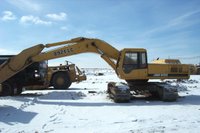 Have you all been watching The Colbert Report? At first I had mixed feelings when Stephen Colbert left the Daily Show to become the proprietor of his own show. He was one of the main reasons I watched the DS in the first place. I still miss his "This Week in God" segments, though Rob Cordrey's version of same is wonderful in its own way. But the older bits like the "Even Stev/phen" segment that featured Colbert and Steve Carell were consistently brilliant and hilarious.
Have you all been watching The Colbert Report? At first I had mixed feelings when Stephen Colbert left the Daily Show to become the proprietor of his own show. He was one of the main reasons I watched the DS in the first place. I still miss his "This Week in God" segments, though Rob Cordrey's version of same is wonderful in its own way. But the older bits like the "Even Stev/phen" segment that featured Colbert and Steve Carell were consistently brilliant and hilarious. But all good things must be cancelled or spun off or moved to a new timeslot, right? The Colbert Report is fast becoming a great show in its own right, though the cult of St. Stephen can be overwhelming at times. But, if you have seen the show, you have to admit that the writing is spectacular and Colbert's delivery is usually spot on.
But all good things must be cancelled or spun off or moved to a new timeslot, right? The Colbert Report is fast becoming a great show in its own right, though the cult of St. Stephen can be overwhelming at times. But, if you have seen the show, you have to admit that the writing is spectacular and Colbert's delivery is usually spot on.Tonight's Word was "Trial Separation" -- a riff on the idea that the separation of church and state is gradually being eroded in the U.S. After all, "In god We Trust" is written on U.S. money "right where Jesus would want it to be", he tells us. It's an old, but still apt observation. But this is The Comedy Network, right? So, instead of picking too deeply at our various spiritual wounds, Colbert pushes the discourse into the realm of the absurd with a 2-minute comparison of major religious end-of-the-world stories. And these are compared with a Toyota Camry of all things! Playing on the consumer notion that anything can be bought and sold, Colbert suggests we comparison shop for an end of the world story that provides value and comfort -- and, if possible, the safety afforded by side-impact air bags. It made me laugh but I can't decide whether it was as funny and smart as it seemed or whether it was just an excuse for a product placement. Or both.
 Which brings me to the real enigma that is Stephen Colbert: unlike John Stewart, he almost never shows his political cards. Maybe good satire always needs an element of suspense, a way of keeping the audience on edge as they try to guess what the satirist really thinks. If that is true, then Colbert is the Alfred Hitchcock of TV satire.
Which brings me to the real enigma that is Stephen Colbert: unlike John Stewart, he almost never shows his political cards. Maybe good satire always needs an element of suspense, a way of keeping the audience on edge as they try to guess what the satirist really thinks. If that is true, then Colbert is the Alfred Hitchcock of TV satire.




